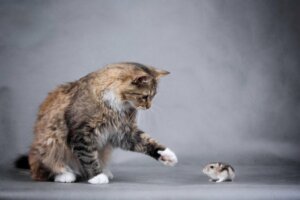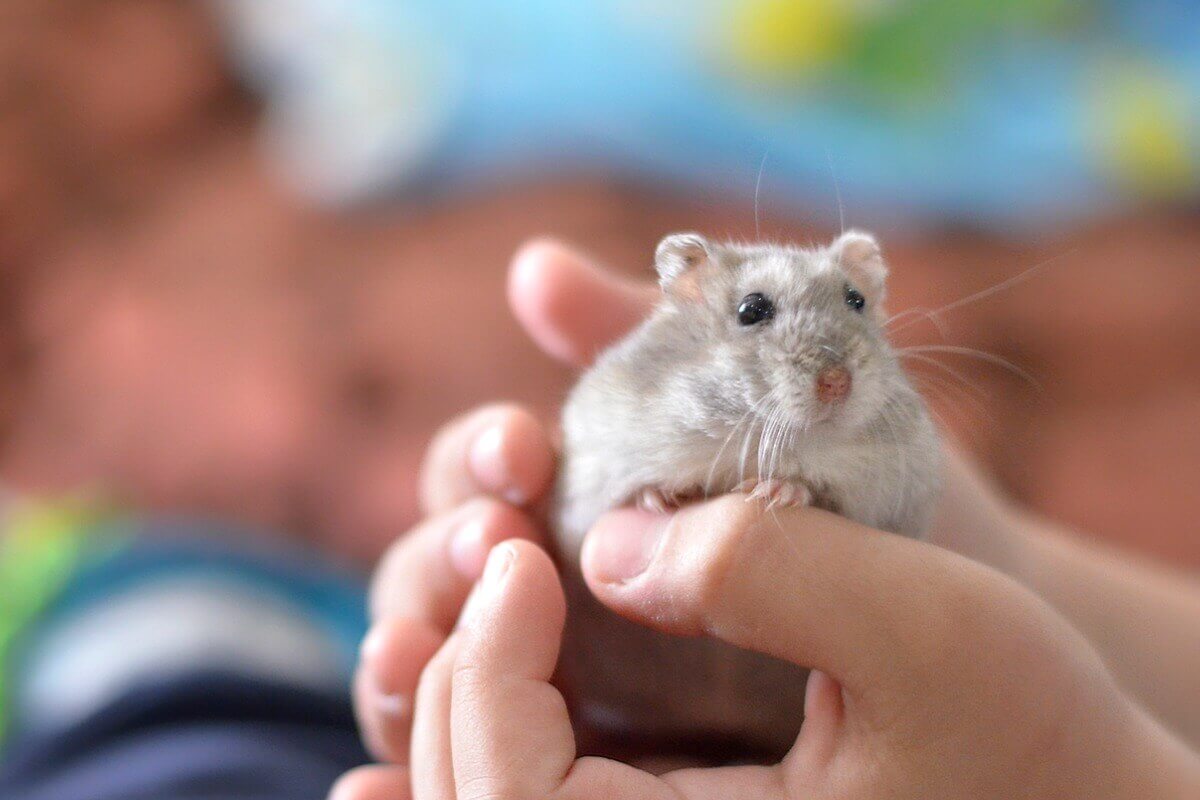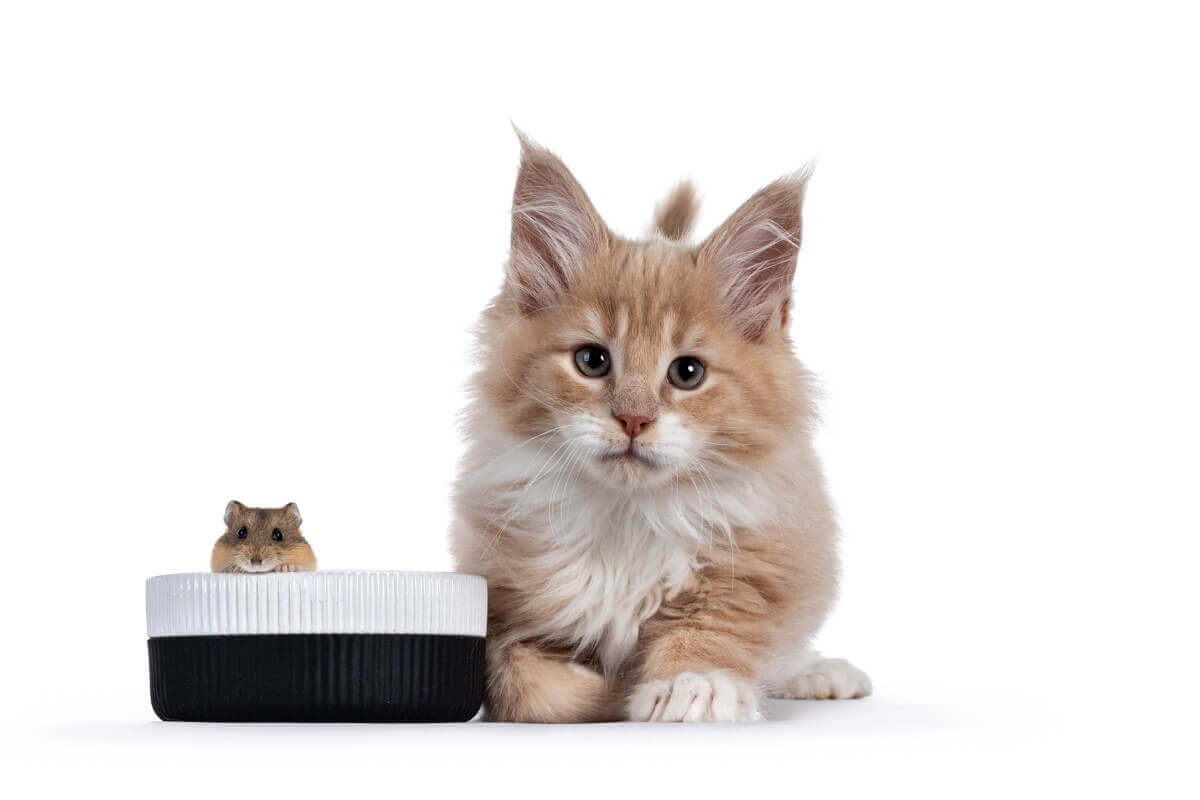Is It Possible for Cats and Hamsters to Live Together?

If you’re an animal lover, then you’ll love welcoming any species into your home. However, you also need to evaluate the compatibility between pets, as some may not get along so well. This is the case when it comes to cats and hamsters, although it’s perfectly possible for them to get along if certain circumstances are provided.
It’s important not to forget the nature of both species, as the cat has hunting instinct and the hamster of prey. Here, we’ll tell you the secrets you need to know so that both animals can lead a peaceful and stress-free coexistence. Keep reading.
Do cats and hamsters get along well?
The most obvious answer is no. However, it’s not an antagonism like a cat and a dog might have, as the latter would be competitors in nature: Both being carnivores and hunters, with similar prey and marked territoriality.
In the case of cats and hamsters, the relationship they have is different, as the feline will see the rodent as prey. They can’t get along because the former will want to eat the latter and the latter, obviously, doesn’t want to be eaten. On this basis, the coexistence between cats and hamsters isn’t possible in a natural way.

My cat plays with rodents but doesn’t kill them
For felines, hunting and playing are closely related. From the time they’re able to move on their own, the mother trains her kittens to hunt by showing them how to catch live prey. So even if a domestic feline has no intention of killing a rodent, the games it plays with it can be dangerous.
A cat that has access to the outdoors will be more likely to see the hamster as prey because while it’s outside unsupervised, it can give free rein to its hunting instinct. An illustrative example of all this is reported in a 2013 study: Domestic cats in the wild kill 1.3 to 4 billion birds and 6.3 to 22.3 billion mammals a year in the United States.
Is it possible to achieve coexistence between cats and hamsters?
Although it’s highly unlikely that both animals are going to be best friends, it is possible to achieve get both to coexist peacefully in the same home. To do this, you have to work with both animals: With the cat, so that it doesn’t see the hamster as prey, and with the rodent, so that it’s able to be close to the feline without getting stressed. Here are some useful tips to achieve this.
Keep your hamster safe
Especially at the beginning of the relationship, your hamster’s environment should be safe. If possible, the cat shouldn’t have access to the room and the rodent shouldn’t be able to escape from it.
Even if the cat can’t get the hamster out of the cage, just having it close by will cause the rodent a lot of stress.
Once the hamster is used to the cat’s presence (which you can do by following the instructions in the next section), you’ll only have to supervise their interactions and keep the hamster cage in a place where the cat can’t knock it over or open it. A good option is to put it up high and against a corner.
Make a good presentation
Introducing the 2 animals correctly is the key to helping make coexistence easier. To do this, do the following:
- Let the cat approach the cage: Always under supervision, let both animals see each other through the bars. This way, they can smell each other and gradually get used to each other’s presence.
- Introduce the hamster: Take the hamster in your hands and introduce it to the cat. It’s a good idea to ask for help from another person to hold the feline in case it pounces on the rodent. Use a soft tone, pet the hamster to reassure it, and never force the exposure times.
- Train your cat: During the previous 2 steps, whenever the cat makes an attempt to treat the hamster as prey, respond with a firm no and end the interaction. On the other hand, whenever it acts peacefully (sniffing, ignoring, etc.), reward it.
- Repeat these steps as many times as necessary: The personalities of both animals may make the process shorter or longer, but that doesn’t mean it’s impossible.
Always supervise the time they spend in the same room
Coexistence between cats and hamsters, even with a good introduction, is never without risk. Therefore, whenever both animals are in the same space, you need to be present and pay close attention. Otherwise, an accident could happen (even if the cat has no intention of catching the hamster) and you arrive too late.
What if I can’t get my cat and hamster to get along?
In that case, you’ll have no choice but to keep them in separate rooms. Ideally, the cat shouldn’t have access to the room where the hamster lives. In that same room, you’ll have to prepare a space for the rodent to make their daily outings and make sure they can’t escape under the door or through some other opening.
Some people use plastic rolling balls as a “safe” method for the hamster to walk around the house because that way, the other animals have no chance of attacking it. However, we discourage this practice, as these balls are a major source of stress in the rodent. What’s more, they can contribute to heatstroke as well as other associated problems.

In any case, if you don’t get both animals to tolerate each other, don’t despair; it’s an incompatibility resulting from the natural tendencies of both species, not your performance. The important thing is for both cat and hamster to live happily and healthily sharing quality time with you (and not with each other).
If you’re an animal lover, then you’ll love welcoming any species into your home. However, you also need to evaluate the compatibility between pets, as some may not get along so well. This is the case when it comes to cats and hamsters, although it’s perfectly possible for them to get along if certain circumstances are provided.
It’s important not to forget the nature of both species, as the cat has hunting instinct and the hamster of prey. Here, we’ll tell you the secrets you need to know so that both animals can lead a peaceful and stress-free coexistence. Keep reading.
Do cats and hamsters get along well?
The most obvious answer is no. However, it’s not an antagonism like a cat and a dog might have, as the latter would be competitors in nature: Both being carnivores and hunters, with similar prey and marked territoriality.
In the case of cats and hamsters, the relationship they have is different, as the feline will see the rodent as prey. They can’t get along because the former will want to eat the latter and the latter, obviously, doesn’t want to be eaten. On this basis, the coexistence between cats and hamsters isn’t possible in a natural way.

My cat plays with rodents but doesn’t kill them
For felines, hunting and playing are closely related. From the time they’re able to move on their own, the mother trains her kittens to hunt by showing them how to catch live prey. So even if a domestic feline has no intention of killing a rodent, the games it plays with it can be dangerous.
A cat that has access to the outdoors will be more likely to see the hamster as prey because while it’s outside unsupervised, it can give free rein to its hunting instinct. An illustrative example of all this is reported in a 2013 study: Domestic cats in the wild kill 1.3 to 4 billion birds and 6.3 to 22.3 billion mammals a year in the United States.
Is it possible to achieve coexistence between cats and hamsters?
Although it’s highly unlikely that both animals are going to be best friends, it is possible to achieve get both to coexist peacefully in the same home. To do this, you have to work with both animals: With the cat, so that it doesn’t see the hamster as prey, and with the rodent, so that it’s able to be close to the feline without getting stressed. Here are some useful tips to achieve this.
Keep your hamster safe
Especially at the beginning of the relationship, your hamster’s environment should be safe. If possible, the cat shouldn’t have access to the room and the rodent shouldn’t be able to escape from it.
Even if the cat can’t get the hamster out of the cage, just having it close by will cause the rodent a lot of stress.
Once the hamster is used to the cat’s presence (which you can do by following the instructions in the next section), you’ll only have to supervise their interactions and keep the hamster cage in a place where the cat can’t knock it over or open it. A good option is to put it up high and against a corner.
Make a good presentation
Introducing the 2 animals correctly is the key to helping make coexistence easier. To do this, do the following:
- Let the cat approach the cage: Always under supervision, let both animals see each other through the bars. This way, they can smell each other and gradually get used to each other’s presence.
- Introduce the hamster: Take the hamster in your hands and introduce it to the cat. It’s a good idea to ask for help from another person to hold the feline in case it pounces on the rodent. Use a soft tone, pet the hamster to reassure it, and never force the exposure times.
- Train your cat: During the previous 2 steps, whenever the cat makes an attempt to treat the hamster as prey, respond with a firm no and end the interaction. On the other hand, whenever it acts peacefully (sniffing, ignoring, etc.), reward it.
- Repeat these steps as many times as necessary: The personalities of both animals may make the process shorter or longer, but that doesn’t mean it’s impossible.
Always supervise the time they spend in the same room
Coexistence between cats and hamsters, even with a good introduction, is never without risk. Therefore, whenever both animals are in the same space, you need to be present and pay close attention. Otherwise, an accident could happen (even if the cat has no intention of catching the hamster) and you arrive too late.
What if I can’t get my cat and hamster to get along?
In that case, you’ll have no choice but to keep them in separate rooms. Ideally, the cat shouldn’t have access to the room where the hamster lives. In that same room, you’ll have to prepare a space for the rodent to make their daily outings and make sure they can’t escape under the door or through some other opening.
Some people use plastic rolling balls as a “safe” method for the hamster to walk around the house because that way, the other animals have no chance of attacking it. However, we discourage this practice, as these balls are a major source of stress in the rodent. What’s more, they can contribute to heatstroke as well as other associated problems.

In any case, if you don’t get both animals to tolerate each other, don’t despair; it’s an incompatibility resulting from the natural tendencies of both species, not your performance. The important thing is for both cat and hamster to live happily and healthily sharing quality time with you (and not with each other).
All cited sources were thoroughly reviewed by our team to ensure their quality, reliability, currency, and validity. The bibliography of this article was considered reliable and of academic or scientific accuracy.
- McDonald, J. L., Maclean, M., Evans, M. R., & Hodgson, D. J. (2015). Reconciling actual and perceived rates of predation by domestic cats. Ecology and Evolution, 5(14), 2745-2753.
- Loss, S. R., Will, T., & Marra, P. P. (2013). The impact of free-ranging domestic cats on wildlife of the United States. Nature communications, 4(1), 1-8.
- Langley, W. M. (1985). Relative importance of distance senses in hamster predatory behavior. Behavioural processes, 10(3), 229-239.
This text is provided for informational purposes only and does not replace consultation with a professional. If in doubt, consult your specialist.








